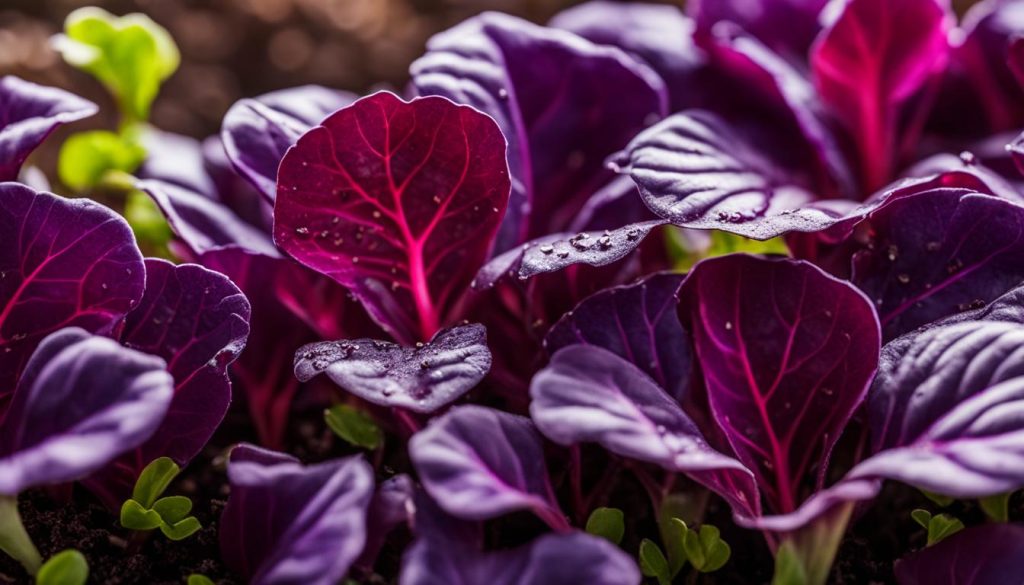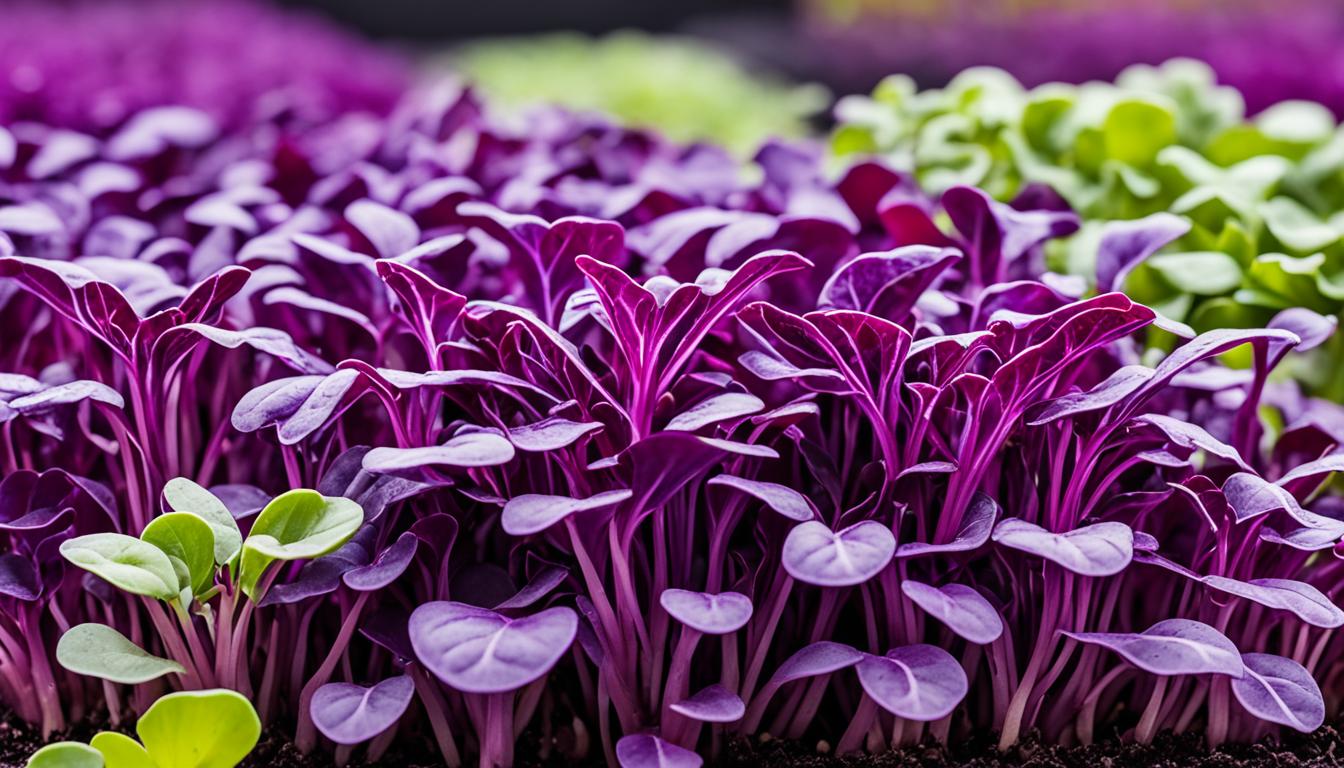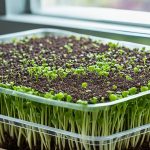Diving into the world of home-grown greens begins with the easiest and perhaps most rewarding of tasks—cultivating red cabbage microgreens. This beginner-friendly endeavor not only garnishes your kitchen with a splash of color, but it also provides the freshest, most flavorful leaves that can be harvested right from your windowsill. Let’s embark on a verdant journey and discover the joys of learning how to grow red cabbage microgreens, turning your space into a miniature garden brimming with nutrition and taste.
Whether you’re short on space or simply keen on quick crops, red cabbage microgreens are a fantastic option—fast-growing, densely nutritious, and delightfully vibrant. Their rich hue and crisp texture make every dish more visually striking and nutritionally substantial. Join us as we guide you through each step towards achieving a flourishing batch of these lovely greens straight from your home.
Understanding the Appeal of Red Cabbage Microgreens
Red cabbage microgreens are not only a sight to behold but also a nutritional goldmine, making them a favorite among health-conscious individuals and food enthusiasts alike. Their vivid colors and robust flavors bring a new dimension to culinary creations, while their health benefits cement their status as a superfood in the plant kingdom.
Comparing Nutritional Value: Red Cabbage Microgreens vs Mature Cabbage
When it comes to red cabbage microgreens nutrition, these tiny greens are nothing short of extraordinary. Loaded with an array of vitamins and minerals, red cabbage microgreens leave their mature cabbage relatives in the dust. Rich in vital nutrients such as vitamins C and E, dietary fiber, and beta carotene, they also boast a higher concentration of glucosinolates and polyphenols—compounds renowned for their cholesterol-combating abilities.
The Beauty and Flavor of Red Cabbage Microgreens
The aesthetic appeal of red cabbage microgreens is undeniable. With their stunning lavender stems and lush green leaves, they breathe life into any dish. Beyond the beauty, their flavor is a balance of peppery and sweet, making them a versatile ingredient that enhances salads, sandwiches, and more without overwhelming the palate.
Heart Health and Other Compelling Benefits
Embracing red cabbage microgreens can lead to a healthier heart. These greens are not only a tasty addition to your diet but also a protective ally against cardiovascular diseases. Their anthocyanin content, which lends them their characteristic color, plays a crucial role in reducing oxidative stress and possibly preventing cancer. Enjoying red cabbage microgreens is a delicious way to reap benefits that extend far beyond mere nutrition, enriching your overall wellbeing with every bite.
Starting Your Microgreens Journey: Essential Supplies
Embarking on the path to grow the best red cabbage microgreens starts with curating the right set of tools and supplies. Securing top-grade seeds is the first and crucial step. Organic red cabbage seeds from recognized suppliers like True Leaf Market not only guarantee superior growth but also ensure you’re sowing the healthiest plants. These seeds are especially curated for those questioning where to buy red cabbage microgreens that stand out in quality.
Your microgreen toolkit should include two shallow growing trays – one solid and another with drainage holes for effective water management. Coupled with a superior growing medium, such as a high-quality seed starter mix, these trays will provide the perfect cradle for your seeds. A good medium caters to the fragile roots and supports the tender shoots of your microgreens, ensuring robust growth.
Likewise, a reliable grow light, like the T5 model, is essential for simulating ideal sunlight conditions, helping your microgreens flourish with vigor. To keep the tender shoots hydrated, you’ll need a gentle misting bottle, which ensures the delicate leaves are not damaged by aggressive watering methods. Finally, to reap the fruits of your labor, a pair of sharp kitchen shears is indispensable for a clean and precise harvest.
Proper preparation is what separates a flourishing microgreen garden from an attempt that falls short. With these essential supplies at hand, you’ll be well on your way to enjoying some of the best red cabbage microgreens at the convenience of your home.
The Ideal Growing Conditions for Red Cabbage Microgreens
Growing red cabbage microgreens can be a delightful and nutritious addition to your home garden, but creating the perfect environment is essential for their success. These peppery greens thrive under certain conditions, and understanding these can significantly improve your harvest. Implementing the best practices in medium choice, temperature, and lighting not only fosters robust growth but also ensures your microgreens are packed with flavor, making them an exceptional ingredient for any red cabbage microgreens recipe.
Soil vs Hydroponic: Choosing the Right Medium
The debate of soil versus hydroponics often arises when considering how to grow red cabbage microgreens. If you prioritize ease of setup and minimal mess, hydroponic systems are worth exploring. However, for those seeking a more traditional approach, selecting a fine-grained soil like coconut coir provides excellent water retention and nutrient distribution, vital for the germination and growth of your red cabbage microgreens.
Temperature and Light: Key Factors for Growth
The microgreens’ ambient temperature is a major determinant in successful cultivation. Optimize your setup to maintain a steady temperature range between 60 and 70°F for optimal soil conditions, as it accelerates germination and growth. Pair this with consistent, direct grow light for beautifully even growth. Proper lighting ensures your microgreens are not only nutritious but also maintain a radiant hue that makes every dish visually stunning. With these conditions met, your red cabbage microgreens are set to flourish, ready to be the star of countless recipes.
Selecting the Best Red Cabbage Microgreens Seeds
Embarking on the journey of cultivating red cabbage microgreens begins with the crucial choice of seeds. The viability and quality of your microgreens heavily rely upon this initial selection, as it largely determines the success of your harvest. While regular cabbage seeds are suitable for growing microgreens, opting for specialized red cabbage microgreens seeds can yield even better results—leading to a more robust growth and a more plentiful harvest.

True Leaf Market stands out as a purveyor of some of the best red cabbage microgreens varieties available. Their extensive selection includes the vibrant Red Acre, the robust Drumhead, and the Golden Acre—with each variety bringing its own unique hues and flavors to your microgreens collection. Moreover, their Organic Red Acre variety merges the benefits of exceptional quality with the assurance of organic farming practices.
With an emphasis on quality above all, these seeds ensure that gardeners of all skill levels can enjoy the cultivation process from planting to plate. When searching for red cabbage microgreens seeds, it is critical to consider germination rates, purity, and the reputation of the seed supplier. True Leaf Market delivers on all these aspects, making them a go-to resource for gardeners seeking to elevate their microgreens game with reliable and superior seed options.
Planting Your Red Cabbage Microgreens: A Step-by-Step Guide
Embarking on the journey of planting red cabbage microgreens is an exciting venture for any gardening enthusiast or culinary aficionado. By following this simple guide, you’ll be well on your way to growing red cabbage microgreens that are not only packed with nutrients but are also a vibrant addition to your next culinary creation. Let’s get started with the basics of setting up your planting tray.
Soil Preparation and Seed Distribution
The foundation of successful microgreen growth begins with proper soil preparation. Initiate the process by filling your planting tray with a nutrient-rich growing medium, leveled smoothly to offer an even base. Next, scatter your red cabbage seeds generously across the surface, ensuring they are evenly distributed but not overcrowded to avoid competition for space and light as they sprout. A gentle press into the medium ensures good contact but skip the traditional soil covering — instead, these seeds will germinate under a blackout cover to create a cozy, dark environment!
Watering Techniques: Ensuring Adequate Moisture
As seedlings thrive with consistent moisture, the art of watering is crucial. A key technique to master is bottom watering which means you’ll add water directly into the tray beneath the one holding your seeds. The absorbent growing medium draws up the necessary water while dodging the pitfalls of mold or bacterial growth that can come from top watering. Remember to keep the environment humid but not waterlogged, balancing the scales for perfect microgreen growth.
The Blackout Period: Encouraging Germination
Now for the magic of germination! Place a blackout cover over the seeded tray, which effectively mimics the natural state of being buried under soil without needing to bury the seeds. Typically lasting between two to four days, this blackout period is essential to encourage your red cabbage seeds to sprout. Check daily for signs of life and be ready to unveil your mini greens as they make their first appearance, ready for light and growth.
With these steps, you’re on the track to nurturing and growing red cabbage microgreens in your own home garden. Remember, planting red cabbage microgreens is not just an agricultural task, it’s an adventure in mini-horticulture that culminates in a deliciously rewarding experience for your palette and plate.
Sprouting Success: Transitioning From Germination to Growth
When the darkness of the blackout period gives way, what emerges are the first signs of red cabbage microgreens sprouting, pushing up the cover in a unified swell of new life. This moment holds a sense of triumph for gardeners as they witness a successful seed germination, signaling the need to shift gears from the careful watch of germination to the attentive care that promotes robust red cabbage microgreens growth. Adequate light and meticulous moisture management now become the focus, fostering the sprouts as they develop their full and rich color.
As growers oversee this critical phase, they ensure their delicate crops receive balanced, gentle watering and enough light to thrive without stress. It’s during these days that the microgreens reveal their vibrant hues and distinctive flavors, becoming the lush, nutritious greens eagerly anticipated from the initial planting.

Creating the Perfect Environment for Lush Microgreen Growth
To produce fresh red cabbage microgreens, aspiring gardeners must focus on crafting a growth space that is as close to ideal as possible. As such, considering the essentials for microgreens to flourish is crucial. A precise combination of light, temperature, and humidity plays a pivotal role in nurturing these delicate plants.
Choosing the Right Grow Light
Achieving the vibrant hues and healthy stature of red cabbage microgreens depends largely on proper lighting. The T5 grow light emerges as the top contender among indoor gardening enthusiasts for its efficiency in promoting even growth and maintaining the rich coloring of the microgreens. Its spectral output is tailored to the needs of young plants, ensuring that red cabbage microgreens growth environment requirements for light are precisely met.
Managing Temperature and Humidity
Equally significant is the control of temperature and humidity within your growing environment. These red cabbage gems prefer a mild temperature and moderate humidity to optimize development. Meticulously monitoring and adjusting these factors contributes to the health and productivity of your microgreens, leading to that visually enticing and nutritiously dense harvest home gardeners strive for.
The Art of Harvesting Red Cabbage Microgreens
As the vibrant shades of purple and green signal maturity, the harvesting red cabbage microgreens phase begins. This process is not only about reaping what you’ve sown, but also capturing the essence of these nutrient-rich plants at their peak. A timely harvest ensures the intense flavor and high nutritional value that red cabbage microgreens are known for.

When to Harvest for Optimal Flavor and Nutrition
Determining the perfect window for harvest is pivotal. Generally, the sweet spot for harvesting red cabbage microgreens falls between 5-14 days after planting, characterized by the greens reaching a height of 1-3 inches. Pay attention to their height, as well as the thickness of the mat. At this stage, the microgreens have developed their distinctive flavor, while the nutritional content is at its zenith. Harvesting too early may yield less flavorful greens, while waiting too long could result in a somewhat bitter taste.
Best Practices for Clipping and Storing Your Harvest
To ensure a clean cut and minimal damage to the tender microgreens, it is best to use sharp kitchen shears and clip close to the base of the stems. This method helps preserve their freshness and quality. Once the harvest is complete, gently bundling the microgreens in paper towels, followed by housing them in a sealed container, safeguards their moisture and extends their shelf life. Refrigeration is essential to maintain the crispness of the microgreens. Integrating them into a red cabbage microgreens recipe immediately post-harvest is advisable to enjoy their maximum flavor and benefits.
Red Cabbage Microgreens Nutrition: Packed with Vitamins
The diminutive yet mighty red cabbage microgreens are a testament to the phrase “good things come in small packages.” Harnessing a concentration of vital nutrients that dwarf those found in mature vegetables, these sprouts are a vibrant nutritional boon. With studies showing that they contain exponentially higher levels of vitamin K compared to spinach, an essential nutrient for bone health and blood clotting, their nutritional intensity sets a remarkable standard.
But the nutritive accolades don’t end there; these microgreens are a treasure trove of antioxidants, featuring 260 times more carotenoids—pigments that play a crucial role in preventing heart disease and certain cancers—than their fully-grown cabbage counterparts. Their vitamin E content, sitting at 40 times the usual amount, acts as a powerful antioxidant, while the sixfold increase in vitamin C aids immensely in immune system function and skin health.
Truly, the red cabbage microgreens nutrition spectrum extends into impressive realms, surpassing even renowned health foods in nutrient density. They also offer more lutein than spinach, an antioxidant pivotal in eye health that can help stave off age-related macular degeneration. These findings underscore the vast red cabbage microgreens health benefits, making them not just a food but a superfood capable of supporting and enhancing overall wellness.
Innovative Ways to Use Your Fresh Red Cabbage Microgreens
Unlock the full potential of your kitchen creations by using fresh red cabbage microgreens to enhance flavor and foster a vibrant presentation. The culinary applications of these nutritious greens are vast and versatile, catering to both raw and cooked dishes, affirming their role as an essential ingredient in modern home cooking. Whether it’s for their striking color, their crisp texture, or their peppery taste, red cabbage microgreens are more than just a garnish—they’re a way to bring dishes to life.
Incorporating Microgreens into Salads and Bowls
One of the simplest yet most impactful ways to enjoy these delightful sprouts is by incorporating them into salads. A red cabbage microgreens recipe can transform a basic salad into a gourmet experience. Their crisp texture and fresh flavor complement mixed greens, while their deep, ruby hues add a pop of color that elevates the visual appeal of any bowl. Mix them with a combination of lettuces, a sprinkle of nuts, and a drizzle of your favorite vinaigrette for a refreshing and nutritious meal.
Creative Cooking: Using Microgreens in Hot Dishes
Don’t shy away from using fresh red cabbage microgreens in your hot dishes. Topping a steamy bowl of soup with these microgreens injects a burst of color and a tender crunch that complements the rich flavors. When cooking an omelet or whipping up a stir-fry, adding microgreens towards the end of cooking ensures they retain their texture and nutritional value. They’re also a splendid match with creamy pastas and baked casseroles, proving that red cabbage microgreens can stand up to the heat and still shine bright on the plate.
Red Cabbage Microgreens Health Benefits: A Closer Look
Stepping into the arena of superfoods, red cabbage microgreens are not just a treat to the eyes but a boon to our health. They go beyond mere nutritional value, offering profound health benefits that have caught the attention of health enthusiasts and researchers alike. One of the standout red cabbage microgreens facts is their ability to lower bad cholesterol—this comes as great news in our constant battle against cardiovascular diseases.
Their consumption has been associated with reducing weight gain, a struggle for numerous individuals striving for a healthier lifestyle. The presence of sulforaphane, a natural compound in these microgreens, showcases their capacity to combat cancer cells, positioning them as a potent ally in the prevention strategies against the dreaded disease.
Fostering a strong immune system is another gem in their crown of benefits. Packed with vitamin C and other essential nutrients, red cabbage microgreens are more than capable of giving our body’s defense mechanism a significant boost. Furthermore, the dense concentration of antioxidants found in these microgreens hints at their role in enhancing gastrointestinal wellness—a pivotal aspect of maintaining overall health.
Perhaps what’s even more remarkable, emerging laboratory research suggests that red cabbage microgreens might help in reducing the risk of Alzheimer’s disease. These findings highlight the importance of incorporating such nutrient-dense foods into our diets. Embracing these vibrant greens can be a step towards a healthier, more vibrant life.
Where to Buy Red Cabbage Microgreens if You Can’t Grow Them
While cultivating your own red cabbage microgreens can be an immensely satisfying endeavor, not everyone has the space, time, or resources to manage their own crop. Fortunately, there’s no shortage of options for those eager to add these nutritious greens to their diet. Whether you’re looking to jumpstart your journey with a starter kit or searching for fully-grown, ready-to-eat greens, both local and online marketplaces have you covered.
Finding Quality Seeds and Starter Kits
Beginners and experienced gardeners alike sometimes favor purchasing starter kits to ensure they have all the necessary components for successful growth. High-quality red cabbage microgreens seeds are the foundation of any microgreen garden. True Leaf Market is renowned for stocking a wide array of seeds, including those for red cabbage, noted for their high germination rates and excellent yield. Starter kits often come with trays, adequate growing mediums, and detailed instructions, enabling even the greenest thumbs to see successful harvests.
Local Markets and Online Options
If you’re pondering where to buy red cabbage microgreens because growing them isn’t an option, consider visiting your local farmers’ markets. Here, you can often find fresh microgreens sold directly by the growers. Alternatively, online stores are a convenient resource for those looking for either seeds or harvested greens. Choose suppliers committed to freshness and quality, and ensure they provide prompt delivery for optimal taste and nutrition.
Troubleshooting Common Issues When Growing Red Cabbage Microgreens
When embarking on the journey of growing red cabbage microgreens, aspiring gardeners expect a dash of challenge alongside the thrill of cultivation. Despite their general ease of growth, these delicate greens are not without their quirks. The most common roadblock faced is ‘damping off’—a fungal menace that thrives in overly moist conditions, causing the collapse of seedlings. Striking a balance is crucial; ensure consistent but moderate watering to safeguard your verdant crop.
Another test to overcome is the issue of uneven growth, which can result in a microgreens’ mat with varied heights and maturity. This is often an interplay of inconsistent lighting or irregular seed spread. An even hand during the seeding stage and the strategic placement of grow lights can mitigate much of this trouble. Keep a close eye on your seedlings and rotate the grow tray if needed to distribute light uniformly for a harmoniously maturing microgreen population.
In addition, pesky invaders like aphids or fungus gnats may find sanctuary among your red cabbage microgreens. Vigilance and maintaining cleanliness can prevent infestations from taking hold. Should pests find a way, a gentle organic approach, such as neem oil, can help protect your plants without resorting to harsh chemicals. By familiarizing yourself with these red cabbage microgreens facts and proactive solutions, you can anticipate common hiccups and secure a thriving microgreens garden, teeming with nutrition and flavor.


